This year saw everything from the acquisition of a new college to a professional NBA team getting stuck in an elevator. With 2019 drawing to end in a few hours, senior editors at The Beacon compiled a list of their top ten stories of the year. All the lists were then averaged out to create the one here.
No. 10: Portland Trail Blazers get a very Emerson experience
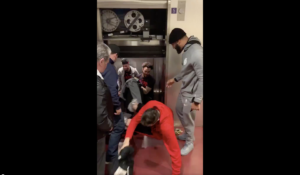
Emerson elevators. They can be likened to a serial kidnapper only instead of locking people in a dimly lit basement they consistently trap community members dangling several stories above ground.
The Portland Trail Blazers learned this the hard way after they found themselves stuck in a campus elevator for 30 minutes. Seven players saw the dark side of the college’s “high-tech” automated vertical movement system and documented the experience on Twitter with a video that had 510,500 views as of publication.
This wasn’t the last time elevators entrapped people. At one point in December, elevators trapped 16 students in two weeks. One student who was stuck in an elevator in fall 2018 likened the experience to the “tower of terror ride.”
Incident journals documented several other incidents of students and faculty falling victim to the college’s elevators this past semester.
No. 9: Men’s basketball wins NEWMAC championship

Emerson isn’t generally billed as the most athletic school considering our reputation as a small liberal arts college but in February, the men’s basketball team started to change that conversation with a 93-75 win to secure the NEWMAC championship.
In the first round of the March NCAA tournament, Rowan University eliminated Emerson in a 96-70 game.
No. 8: Spring Website Malfunction Leaves Students Scrambling to Find Housing
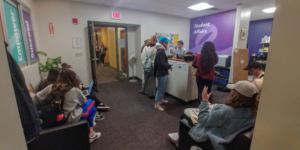
On the first day of suite selection in the spring, all seemed calm as students geared up to choose housing for the fall. The portal crash that followed would cause headaches among students and administrators for months to come.
Issues with the Office of Housing and Residence Life didn’t start with the April crash. The office operated with only one person starting in January when former Senior Associate Director of Housing and Residence Life Seth Hodge left. Associate Director of Housing Operations Kendra Stokes was the only employee in the office at the time of the crash as students piled in looking for a remedy to the website malfunction.
In September, the housing office was operating with five vacancies and in October, the college hired a housing operations coordinator and area coordinator.
No. 7: A Dramatic Year for the Student Government Association
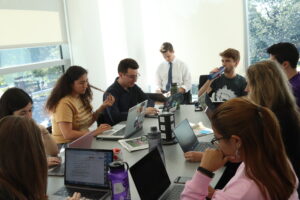
While an SGA story didn’t crack the top five, the combined tales of the spring election, proposed legislation aimed at the EVVYs, and resignation of the executive president certainly made the top ten list.
In the spring, then-sophomore Joseph Davidi and freshman Brady Baca squared off in the executive treasurer race. What would follow would be described by one former SGA official as surreal and surprising.
Neither of the two original candidates would take office in the fall. Instead, a write-in campaign that didn’t even win the election would secure the position. After losing to both Baca and Davidi (both dropped out in the course of the election cycle), then junior Abigail Semple would assume the executive treasurer position for the 2019-20 academic year.
In an election that drew 875 votes, Davidi secured a landslide victory over the other two candidates with 383 votes. Baca managed to draw 240 votes while Semple earned only 86. Both Davidi and Baca turned down the position after finding out the results leaving it to Semple.
Semple’s tenure did not start without controversy.
In the fall, Semple proposed a policy within the Financial Advisory Board that would largely bar student organizations from charging participation fees—removing a crucial source of funding for several organizations. Several SGA officials immediately came out against the idea including then Executive Vice President Will Palauskas and President Raz Moayed.
Semple’s proposal followed a months-long hiring dispute with the EVVYs—an organization that would take the brunt of the amendment, losing almost $25,000 in ticket sales. One student, who wanted to remain unnamed out of fear of retaliation for their comments, recalled in an interview that Semple had even stated she wanted to defund the EVVYs in a room of people during the election cycle.
The legislation eventually went before the board where it was unanimously voted it down. As the executive treasurer, Semple only votes in the case of a tie.
Finally, to wrap a year full of fireworks, the race for the SGA executive presidency faced turmoil of its own after two candidates originally slated to run abruptly dropped out. The unusual December race came about when Moayed stepped down to travel to Emerson’s Los Angeles campus in the upcoming spring semester.
No. 6: Journalism Department Removes Longtime WEBN Advisor

For over 20 years, Journalism Professor Marsha Della-Giustina served as the faculty advisor to WEBN. Journalism Department Chair Janet Kolodzy removed her from her post as an advisor in October after a survey students participated in asking what they found beneficial about their programs and what could be improved.
The decision sparked contentious encounters between current students and alumni over social media. Kolodzy said she retained the final decision to remove Dell-Giustina and declined to provide an exact reason for the removal.
No. 5: A List of “Abusers” Appears on Little Building
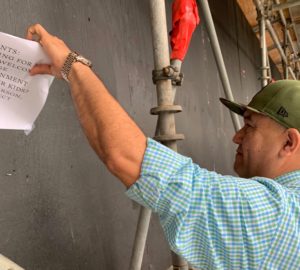
At the end of the spring semester, the college removed graffiti and a list of names accusing more than 12 students of sexual misconduct.
The accusations followed an impromptu gathering of students who claimed the college protects “abusers” and does not properly handle sexual misconduct cases, according to the original Facebook event page.
In an interview at the time, Pelton said the college does not tolerate sexual misconduct and “every single report of misconduct has been received and acted upon appropriately without exception.”
One of the organizers posted on Twitter at the time that they did not know who put up the list.
The organizers of the event shared a Google form where students could submit names of students they did not feel comfortable seeing at the event.
The sequence of events spurred Pelton to form a working group of students, faculty, and senior administrators with intentions to meet in the fall to examine current practices around Title IX. A member of the committee told The Beacon in September that no concrete policy changes could be expected from the group.
The removal of graffiti and the formation of the working group follows a high-profile lawsuit against the college in August 2014 which accused the college of Title IX violations, negligence, negligent infliction of emotional distress, and intentional infliction of emotional distress.
Jillian Doherty, who filed the suit along with two other students, claimed the college failed to educate students about resources related to sexual assault and substance use. She also accused both the college and former Director of Community Standards and Student Conduct Michael Arno of negligence and negligent infliction of emotional distress.
In October 2017, a federal judge in Massachusetts ruled in favor of the college on all four counts Doherty made against Emerson.
No. 4: Straight Pride Parade

Contentious encounters and conflicting ideologies engulfed downtown Boston as the city’s first straight pride parade passed Emerson College during move-in weekend.
Parade-goers, surrounded by a large Boston police escort, aimed to spread awareness of alleged issues impacting straight people. While one Beacon headline read “descended on campus,” the parade drew a low number of floats and a significantly larger counter-protest.
For months over the summer leading up to the event, the city of Boston dealt with applications from the parade’s organizers and wrestled with the idea of free speech. Super Happy Fun America received the permits to hold the parade in late June after the proposed event stirred national controversy.
Prominent politicians including U.S. Rep. Alexandria Ocasio Cortez, D-N.Y., denounced the parade. Pelton added his voice to the mix by calling the event a “perversion.”
No. 3: Endless Construction
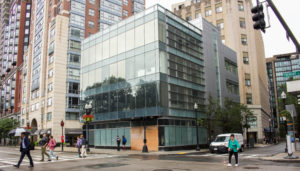
For Emerson students, a feeling of helplessness resides in each of our hearts: will the hardhats, jackhammers, and heavy machinery ever move on from Boylston and Tremont streets?
While the answer might not be what they are looking for, one thing is for certain: the college underwent a large transformation over the past year with the exorbitant amount of construction wrapping up or just beginning.
To name all of them would take far too long and more space than editors granted for this undertaking. However, four projects come to mind when thinking about the endless stream of equipment making its way to and from our small downtown campus.
The landmark renovation of the historic Little Building came to a close this semester (or at least partially). Outfitted in blue T-shirts and colorful makeup, orientation leaders welcomed more than 900 freshmen to the renovated dorm building in early September.
While students moved and settled down for the semester, some construction involving various rooms and practice spaces still persists. Vice President and Dean of Campus Life James Hoppe told The Beacon in October 2018 that construction in the basement and first floor of Little Building would finish in fall 2019—a date now in the rearview mirror.
Just around the corner is “The Commons.” No not the park, Emerson’s brand new student center.
At last check, the name of the building at 172 Tremont St. was unofficial unlike the stated purpose of the building: a place for student activities and common space for the community. The building went through a spate of delays with the original opening scheduled for January 2019. The timeline was extended to March 11 and finally May. It officially opened on Sept. 2 with an open house attended by approximately 400 students.
After purchasing the building for $24 million in November 2017, the college set out to renovate the interior for approximately $2 million. Public records in the form of building permits later detailed a $3.1 million project valuation by the city of Boston—a $1.1 million increase in the original price tag.
Just as students got used to the idea of no scaffolding or construction on Boylston Street, Emerson embarked on a $1 million quest to expand and renovate the sidewalk from the corner of Boylston and Tremont streets to the entrance of Boylston Place.
Administrators tantalized students with the idea of benches, planters, and the elimination of the parking lane on Boylston Street. The first phase of construction was slated to end in December 2019 while the second begins in April 2020 and finishes in September.
Finally, one would be remiss to omit the $2 million Dining Center expansion that added 200 seats at the cost of one fairly popular nightclub. The renovated space took the name “Lion’s Den” after receiving the most votes from students in an online survey.
As a side note, refrain from searching the name online in public unless you’re fine with seeing an adult superstore focused on “pleasure, passion, and romance.”
No. 2: A Year Marked by Grief
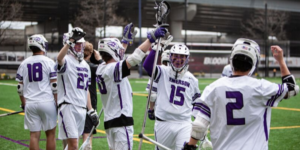
For all the high points over the past year, many dark moments of grief marked 2019 as community members mourned the deaths of several figures within the college.
At the outset of the semester, renowned photographer and longtime faculty member at Emerson David Akiba died after battling cancer for almost a year. Akiba is survived by his wife, six children, and eleven grandchildren.
Akiba began teaching photography classes in 1993 and retired in 2018 where he was then diagnosed with cancer. His work appears in collections at the Boston Museum of Fine Arts, the Library of Congress, the Harvard Fogg Art Museum, the Brooklyn Art Museum, and the Boston Public Library, among other venues.
The early loss in August would become an all too familiar feeling by the end of the semester as Emerson would lose two more beloved community members.
Sophomore Daniel Hollis died in early October following an altercation in Brighton that left the Emerson lacrosse player on life support. Hollis was leaving a party on Sept. 28 with friends when a group of college-aged men approached them. Hollis sustained injuries to his head when he was hit and fell on cement, according to an email from President M. Lee Pelton.
Boston police eventually ruled the sophomore’s death a homicide and the United States Marine Corps confirmed Lance Cpl. Samuel London’s involvement. The Corps previously stated that they were in the process of removing London from their service so he could face potential charges in the investigation.
Less than a month after Hollis died, Journalism Professor Moses Shumow was struck by an outbound commuter train in Beverley while riding his bike through a pedestrian lane early in the morning. Shumow is survived by his wife and three children.
Shumow taught Editing and Web Producing during fall 2019 and advised WEBN alongside fellow journalism professor Stephen Iandoli. The pair took over after the journalism department removed longtime WEBN advisor Marsha Della-Gustina. The late professor moved to Boston before fall 2019 after nine years of teaching at Florida International University where former students recalled his kindness in the classroom.
Faculty, staff, students, relatives, and friends came together during these times of tragedy to overcome the unthinkable, the loss of loved community members. While media swarmed campus during the deaths of Hollis and Shumow, the far too often vigils provided a much needed space for healing.
No. 1: Marlboro College Finds Potential Savior in Emerson College
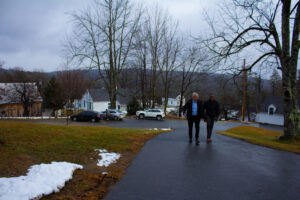
No, Emerson didn’t buy a zoo as many memes this semester suggested. The college has nothing to do with the cigarette brand or Marlborough, MA. Instead, Emerson is set to acquire a small college in rural Vermont by the same name.
In simultaneous town halls in Vermont and Boston, Pelton and Marlboro College President Kevin Quigley announced Emerson’s acquisition of the small liberal arts institution in early November. The two events drew vastly different reactions—one campus reacted with glee and excitement while the other found themselves facing grief and uncertainty.
While much of the specifics of the deal remain to be worked out, fear for the future of the physical campus runs high among current and former Marlboro alumni, employees, and students. As part of the proposed deal, the Vermont institution would transfer its $30 million endowment to Emerson’s Institute for Liberal Arts and Interdisciplinary Studies. The deed to the Vermont campus would also fall to Emerson.
Officials in both colleges are relying on several working groups made up of members from each community to work out the details of the merger. The two colleges are running up against the clock, however, as Marlboro is slated to close at the end of the spring 2020 semester unless it receives an injection of $200 million.
The two presidents are hopeful for the future of Marlboro College and a deal very much in its infant stages.
Common threads the two men bring up when discussing positives to the deal revolve around the similarities in culture between the two institutions and keeping the legacy of Marlboro College alive. Pelton confirmed in a previous interview that should the acquisition see itself through, Emerson College will seek to liquidate the physical campus in Vermont before July 1, 2020.
Marlboro alumni, students, and residents of the nearby town have pressed the Marlboro Board of Trustees for more transparency and creative thinking when it comes to deciding the fate of Marlboro College.
A former administrative staffer at the college challenged the Board at an emergency board meeting to give him and a team four days, a space to work on campus, and access to all financial records and documents that were used to decide on a merger with Emerson. In return, the staffer and team pledged to produce a report showing how Marlboro College could accept a class of 2024 in the fall and then work to rebuild. Marlboro released years of financial documents on Dec. 20 that detailed a loss of $11.4 million in net assets in the past year.
At this point, it is unclear whether or not the deal will come to a close as many specifics on both sides of the table need to be worked out in a rather quick timeline. While optimism abounds between the presidents of both colleges, solutions to keep Marlboro operational are being brought forth.